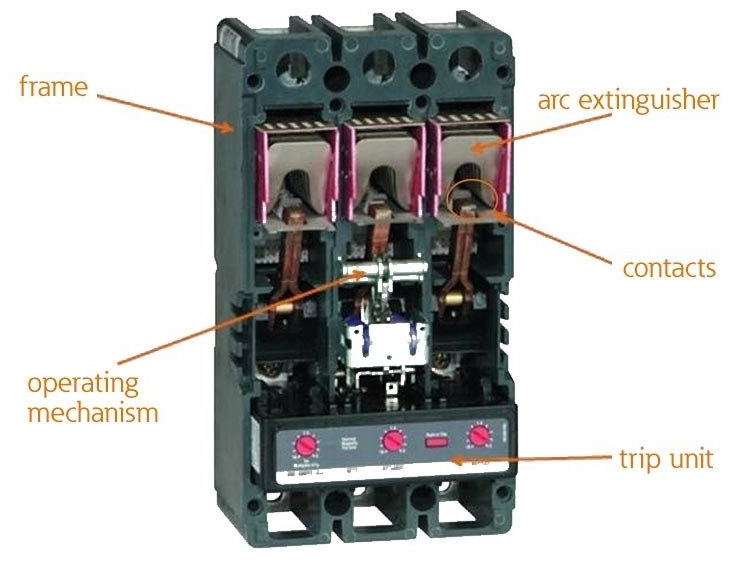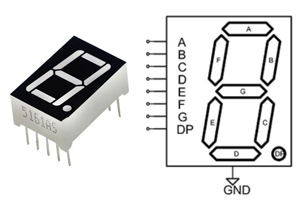Expert Guide to Circuit Breakers: A Simple Breakdown on Types and How They Work
Author:admin Date: 2025-06-13 10:00 Views:352
Circuit Breaker Basics – How do they work?
- Введение
- What Is a Circuit Breaker?
- Circuit Breaker Parts
- How Do Circuit Breakers Work? Working Mechanism
- Types of Circuit Breakers
- Signs of a Failing Circuit Breaker
- Safety Tips and Maintenance for Circuit Breakers
- When to Hire A Professional To Handle Circuit Breakers
- Differences Between Fuse and Circuit Breakers
- Заключение
Введение
Electrical safety is important for anyone looking to keep their appliances and devices safe in a home or office. Different types of devices or mechanisms can achieve this electrical safety. One of them is the use of circuit breakers. It should be interesting to see what circuit breakers are, the types, how they work, and more. That is what this guide covers.
What Is a Circuit Breaker?

Electrical circuit breakers are electrical safety devices that automatically interrupt the flow of current in case there is an overload or short circuit in the electrical circuit. This protective measure helps prevent damage to the electrical components and reduces the chances of electrical fires or other related hazards.
Circuit Breaker Parts

Before you get the Eaton circuit breakers или GE circuit breakers, it is vital to look at the parts of a circuit breaker.
Most circuit breakers will have a frame, operating mechanism, contacts, arc extinguisher, and a trip unit.
The frame is what houses and protects the internal components of a circuit breaker. As for the operating mechanism, it can either be manual or automatic closing and opening. It will have a spring mechanism, handle, or latch system for the operation.
Contacts are the points where current flows in a circuit breaker once it is closed. They are built to withstand high currents that might flow during a fault. You also have an arc extinguisher, which is responsible for extinguishing the arc that may form in case the circuit breaker opens to interrupt a fault.
The trip unit is the mechanism that detects overcurrents or short circuits and then triggers the operating mechanism, opening the circuit breaker.
How Do Circuit Breakers Work? Working Mechanism
The working mechanism is usually the same whether it is the Bryant circuit breakers или ITE circuit breakers. Below is what to expect with circuit breakers.
Normal Operation
During normal operation, the contacts are closed. This is when the circuit breaker is in the “ON” or closed position. In this case, the contacts touch each other; thus, current flows in the circuit.
The operating mechanism, which can be a spring, holds the contacts together to ensure a secure connection.
Detecting Overload/Short-Circuit
If the current overload exceeds the breaker’s capacity, a bimetallic strip heats up and bends, triggering the trip mechanism.
A short circuit can cause a sudden surge in current, which, in addition to thermal overload, activates an electromagnet and triggers the trip mechanism.
Opening the Circuit
At this point, the trip mechanism releases a lever or latch, separating the contacts.
It is common for an arc or sparks to form during the tripping process. The arc extinguisher comes in handy to rapidly extinguish it and prevent any potential damage.
Resetting the Circuit Breaker
It can be manual or automatic. The manual reset is the most common. Once the short circuit or overload is addressed, you can simply flip the switch back on to the “ON” or closed position.
Some models of circuit breakers are designed to reset automatically. They are not commonly used for residential applications.
Types of Circuit Breakers

Expect to come across different types of categorizing the circuit breakers. We will focus on the most commonly used types to better understand what they do and how they can be used.
Miniature Circuit Breaker (MCB)
As the name suggests, MCBs are smaller and more compact circuit breakers. They are mostly used for low-current applications, such as residential and commercial setups.
Their job is to offer the best protection against overloads and short circuits. They are also available with different trip curves. These include B, C, and D, which determine how fast the MCB responds to overcurrent.
Molded Case Circuit Breakers (MCCB)
The molded case circuit breakers are built to be more robust than the MCBs. This makes them ideal for higher current ratings and other fault levels.
As expected, they provide more protection against overcurrent and short circuits than what the MCB would offer.
They get a molded case that protects the internal breaker components.
Air Circuit Breaker (ACB)
This type of circuit breaker uses air to extinguish the arc that forms when a fault occurs. They are typically found in high-current applications, such as the master circuit breakers found in factories.
We recommend such breakers for high-voltage applications.
Residential Current Circuit Breaker (RCCB)
For this type, they detect and interrupt current flow in case there is a fault in the ground. This is important for protecting against electrical shock and electrocution as it can detect and isolate ground faults.
Прерыватель цепи замыкания на землю (GFCI)
These are built to be similar to the RCCBs. The difference is that they are installed in specific areas known to have a higher risk of ground faults. Such include kitchens and bathrooms.
They work to protect you against electrocution by quickly interrupting the circuit in case of a ground fault.
So, before replacing electrical circuit breakers, make sure you understand which one it is you need to install for the right protection.
Signs of a Failing Circuit Breaker
Based on the types of circuit breakers, you can expect them to work in a certain way. However, if the circuit breaker fails, it might show some signs you should know about. Here are some of them:
- A breaker tripping is normal, but the breaker has a fault if it trips more frequently without overload.
- You may also notice the circuit breaker overheating even after it is reset. This overheating leads to malfunction.
- A burning smell from the electrical panel may indicate that your breaker is failing or overheating.
- Look for physical damage, such as scorch marks or frayed wires. If present, immediate attention is required to reinstall the correct circuit breaker.
- It can also be a sign if the breaker does not stay in the ON position after resetting. Just make sure the fault is corrected first and take note of this.
- Sometimes, flickering lights can signal that the circuit breaker is struggling to keep the contacts closed. So long as there is no fault and you experience such, it is best to have it checked.
Safety Tips and Maintenance for Circuit Breakers
Before you can open a Pushmatic circuit breaker, there are some safety tips for you to keep in mind. The first is to turn off all power. This should help minimize the chances of an electrocution. You can use a voltage tester to confirm if the circuit breaker is still powered.
Wearing protective gear such as insulated gloves, safety goggles, and non-conductive boots helps when working on electrical panels. Still, beware of hot components as part of a circuit breaker since they can get hot while the circuit breaker was on.
As for maintenance, regular inspections should be conducted to look for signs of wear, loose connections, and corrosion. You can still test the circuit to see if the circuit breaker trips correctly.
We do not recommend overloading circuits, as this can lead to electrical hazards. So, do not connect too many appliances or devices to the circuit. Simply follow the manufacturer’s recommendations on how to maintain and test the different classes of circuit breakers.
When to Hire A Professional To Handle Circuit Breakers
Whether it is the GFCI circuit breakers or any other Home Depot circuit breakers, correctly installing them is essential for their functionality and safety. Here is when you would hire a professional electrician to do the job.
- When you notice signs of damage to the circuit breaker, this includes a burning smell, burn marks, and cracks.
- If your breaker constantly trips, indicating an overload, you need a professional to help identify the cause of the fault.
- Sometimes, there could be no obvious overload, but the circuit breaker keeps tripping. In such a case, have a professional diagnose what could be the problem.
- If you are upgrading your home, consider upgrading to a newer and better circuit breaker.
- Sometimes, you might be unsure of the circuit breaker’s age. It is always a good idea to get a professional to inspect it so that you can replace it where necessary.
Differences Between Fuse and Circuit Breakers
The fuse and circuit breakers protect against electrical faults in a circuit. However, the mechanisms are different. Here is a table outlining their differences.
| Особенность | Предохранитель | Circuit Breaker |
|---|---|---|
| Operation | It melts to open a circuit in case of a current overload | Disconnects the circuit in case of an overload or short circuit. |
| Reusability | It cannot be reused | Reusable by resetting it |
| Расходы | Low upfront cost | High upfront cost |
| Response time | Faster response time | Slower response time |
| Type of protection | Thermal protection | Thermal and magnetic protection |
| Приложения | Found in smaller appliances | Used in buildings, homes, and industrial applications |
Заключение
Right now, you know more about why circuit breakers trip and their importance. Having looked at the different types of circuit breakers to help you understand why you need them. Always make sure you use the right type of breaker for an application. Still, consider getting yourself circuit breakers from reputable brands if you want the best value for money.
Пожалуйста, отправьте запрос предложения, мы ответим немедленно.
Часто задаваемые вопросы
Why does the circuit breaker in my house keep tripping?
When a circuit breaker trips more frequently, it means there is a fault in the circuit causing short circuits, overloads, or ground faults. Have a professional look at it. However, if there is no fault, it is a sign of a faulty breaker.
Should I reset the circuit breaker myself?
It is safe to reset the circuit breaker yourself. Once the fault has been addressed, you only need to flip the switch back to the ON position.
How often should a circuit breaker be inspected?
We recommend inspecting the circuit breaker every 3 to 5 years. You can also have it checked if you notice any breaker issues.


